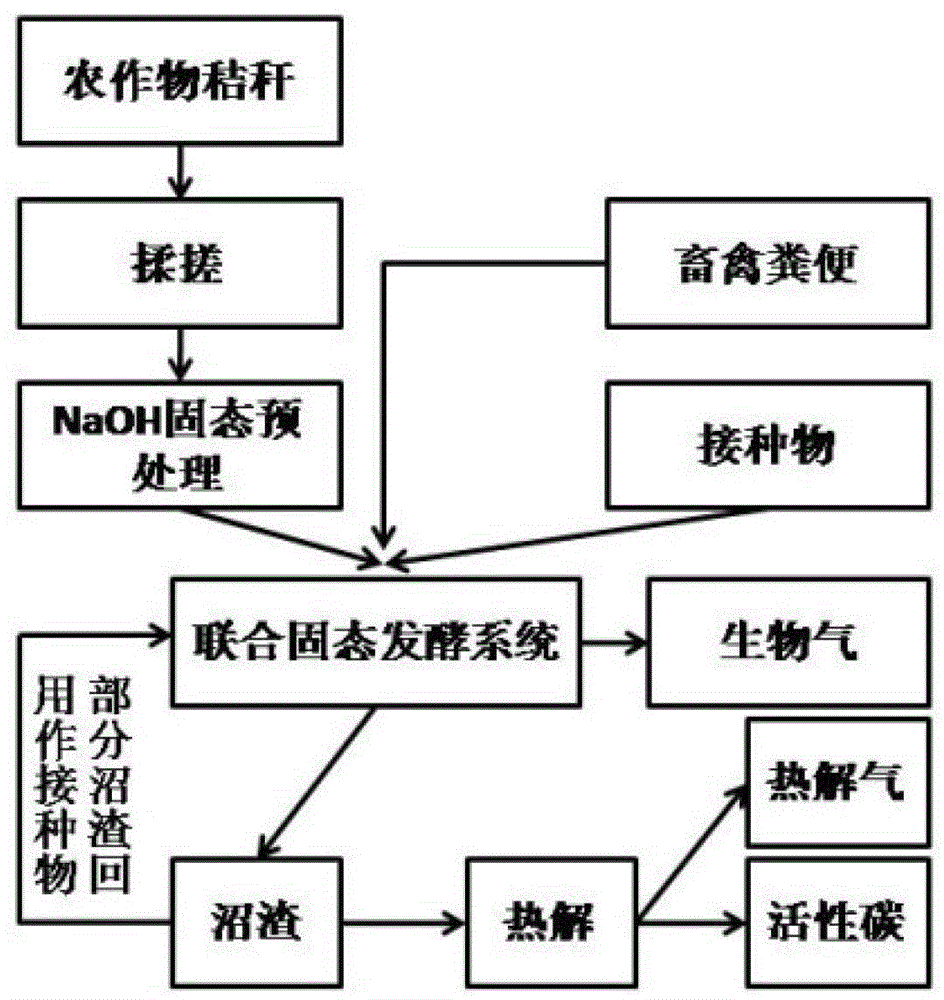Method for producing biogas by combined solid state fermentation of crop straws and excrements of livestocks
A technology of crop straw and solid-state fermentation, applied in fermentation, waste fuel, biological sludge treatment, etc., can solve the problems of not being well developed and utilized, long residence time, large inoculum, etc., and optimize the pretreatment time And structure configuration, the effect of high gas production efficiency
- Summary
- Abstract
- Description
- Claims
- Application Information
AI Technical Summary
Problems solved by technology
Method used
Image
Examples
Embodiment 1
[0019] The first choice is to put 500g of crop straw with a total solid concentration of 0.95 and a volatile solid concentration of 0.9 after kneading into a 5L container, add 23.75g of NaOH, and then add 268g of water. After mixing evenly, seal and store at 20°C for 1 day. Take it out, add 800g of livestock and poultry manure with a volatile solid concentration of 0.2, and then add 1600g of inoculated sludge with a volatile solid concentration of 0.1, so that the solid content of the entire fermentation system is 25%, mix well and put it into an 8L anaerobic reactor middle. The reactor temperature was controlled at 50°C by a water bath jacket. After 21 days of high-temperature solid-state fermentation, it was taken out, and 30% of the biogas residue was used as an inoculum for the next batch of anaerobic fermentation. The remaining 70% of the biogas residue is passed into the pyrolysis reactor for pyrolysis. During pyrolysis, the pyrolysis temperature is 600°C, the heating ...
Embodiment 2
[0021] The first choice is to put 500g of crop straw with a total solid concentration of 0.95 and a volatile solid concentration of 0.9 after kneading into a 5L container, add 25g of NaOH, and then add 300g of water. After mixing evenly, seal and store at 20°C for 1 day. Take it out, add 750g of livestock and poultry manure with a volatile solid concentration of 0.2, and then add 2000g of inoculated biogas residue with a volatile solid concentration of 0.1, so that the solid content of the entire fermentation system is 22%, mix well and put it into an 8L anaerobic reactor middle. The reactor temperature was controlled at 50°C by a water bath jacket. After 24 days of high-temperature solid-state fermentation, it was taken out, and 30% of the biogas residue was used as an inoculum for the next batch of anaerobic fermentation. The remaining 70% of the biogas residue is passed into the pyrolysis reactor for pyrolysis. During pyrolysis, the pyrolysis temperature is 800°C, the hea...
Embodiment 3
[0023] The first choice is to put 500g of crop straw with a total solid concentration of 0.95 and a volatile solid concentration of 0.9 after kneading into a 5L container, add 16g of NaOH, and then add 255g of water. After mixing evenly, seal and store at 20°C for 3 days. Take it out, add 2000g of livestock and poultry manure with a volatile solid concentration of 0.2, and then add 3000g of inoculated sludge with a volatile solid concentration of 0.1 to make the solid content of the entire fermentation system 25%, mix well and put it into an 8L anaerobic reactor middle. The reactor temperature was controlled at 50°C by a water bath jacket. After 24 days of high-temperature solid-state fermentation, it was taken out, and 30% of the biogas residue was used as an inoculum for the next batch of anaerobic fermentation. The remaining 70% of the biogas residue is passed into the pyrolysis reactor for pyrolysis. During pyrolysis, the pyrolysis temperature is 700°C, the heating rate ...
PUM
 Login to View More
Login to View More Abstract
Description
Claims
Application Information
 Login to View More
Login to View More - R&D
- Intellectual Property
- Life Sciences
- Materials
- Tech Scout
- Unparalleled Data Quality
- Higher Quality Content
- 60% Fewer Hallucinations
Browse by: Latest US Patents, China's latest patents, Technical Efficacy Thesaurus, Application Domain, Technology Topic, Popular Technical Reports.
© 2025 PatSnap. All rights reserved.Legal|Privacy policy|Modern Slavery Act Transparency Statement|Sitemap|About US| Contact US: help@patsnap.com

